(Written by William)
When I first heard about the #76429 LEGO Harry Potter Sorting Hat, I was both excited and sad. I was excited because it featured a new sound-brick, and I was sad because I was not interested in Harry Potter sets. So imagine how stoked I was to hear about the #10334 LEGO Icons Retro Radio. It features the same new sound-brick and it is in a non-licensed theme geared towards adults.
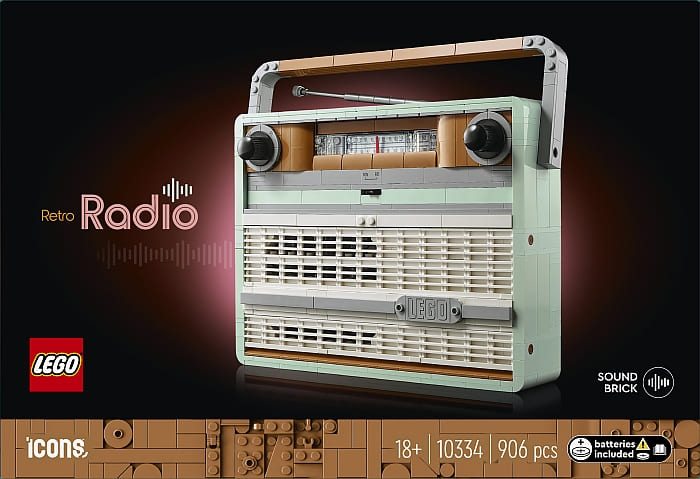
At first, the price of this set seemed a bit high at $99.99. After all, it didn’t look too extravagant, so I simply chalked it up as the cost of the new electronic component. However, I ended up completely blown away by just how advanced the build experience was for this set. Additionally, it has some pretty nice play features, meaning that more than adults might find it interesting. And that’s saying nothing yet about the parts…
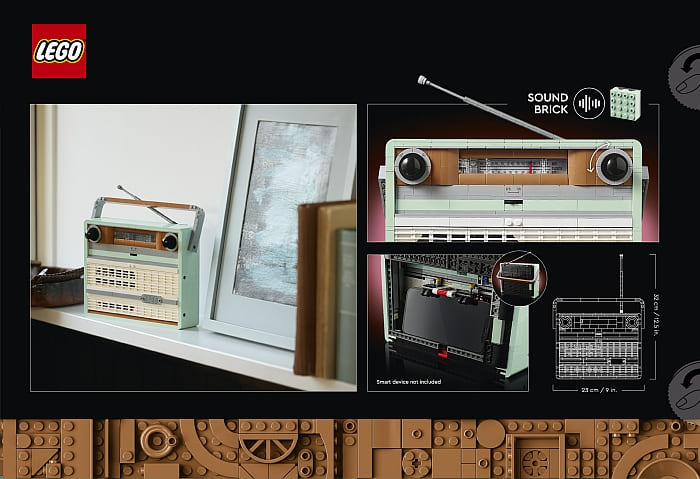
I’d highly recommend this set as a parts pack. You get printed elements including “On” and “Off” tiles, a panel with “AM/FM” on it, and a large tile featuring “LEGO” as a brand for the radio. There are also two tiles that are printed with all the frequencies behind the clear elements at the top. Plus, you get a mess of white fencing to make up the front grill, a good supply of bricks in a pretty light-aqua color, the new sound-brick, and some rather interesting LEGO Technic elements. And it’s a deceptively complex set with all the nifty surprises it holds on the inside. So, with all that, the price is actually fair, but now let’s see how well this radio can play…
LEGO RETRO RADIO – WORMGEAR
Wormgears have been in LEGO’s toolbox for quite some time. If you’re not exactly sure what a wormgear is, just think of the swirly part of a screw or bolt. By twisting this piece, you can turn rotational movement into linear movement. This is also how screws and bolts can either be tightened or loosened, they’re moving in and out even though you twist them around clockwise or counterclockwise.

So, if LEGO already has these pieces, why are we mentioning them here? Well, they introduced a new one. This one is much larger than previous wormgears. In fact, it hardly looks like the tight swirl on a bolt and more like the long swirl of a candy cane. This means it gives us new functionality!
For starters, there is now a specialized brick that will interact with this wormgear. Normal gears might work, but the spacing of the new piece is just a bit too wide to make that practical. So, instead, we have a 2x2x1 2×3 brick with a large hole through the side where the wormgear fits. Inside the hole are several teeth to allow the wormgear to work. Provided that the new brick is next to a flat surface, when you twist the wormgear the new brick will move along it.
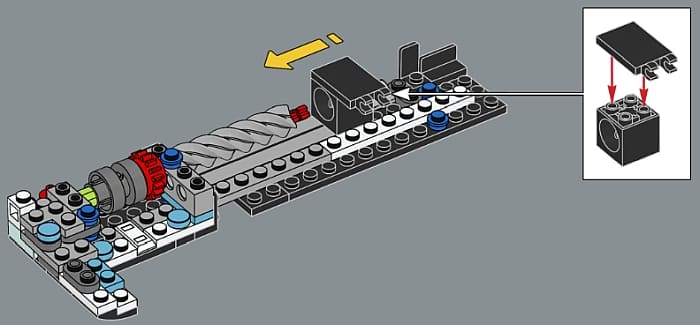
As far as I can tell, we get two major functional benefits from these new parts. The first is that the linear movement is much faster. With the twisted swirls as far apart as they are it takes fewer rotations for the brick to move farther. The second benefit is that this system looks like it can handle more weight. This means things like elevators become more possible and reliable compared to what we had to work with before this part came along.
As for where it is used in the model, it controls the needle that tells you where on the bandwidth the radio is set to. Previously, you could have had the same functionality, but you had to change the gearing on the knob on the right to have a larger driving gear for the shaft the wormgear was on. This would in turn increase the speed of the shaft, which is never healthy for any machine you want to build. It’s always best to use the right part for the right job and with this wormgear, our options have just increased.
LEGO RETRO RADIO – ROTATIONAL MACHINE SWITCH
I’ve seen this particular setup in two different sets; the #10273 LEGO Haunted House from the LEGO Icons Fairground Collection, and the #42107 LEGO Technic Ducati Panigale V4 R motorcycle. In the Haunted House, this switch was made to be an instant release for the elevator mechanism to allow you to drop the elevator whenever you wanted. In the motorcycle, it was built as a gear shift. Shifting gears would then change the rate at which the pistons in the engine moved. In the Retro Radio, it acts as an on-and-off switch in order to activate the sound-brick.
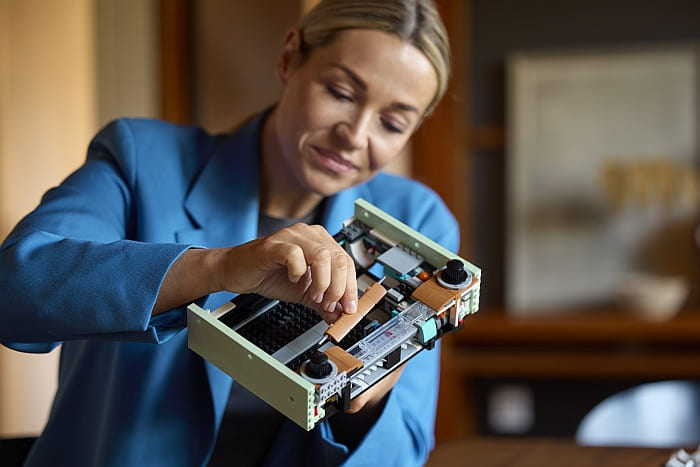
Functionally, the switch in the radio works like in the elevator; it either connects or disconnects to the drive shaft. However, the radio’s build is more like the motorcycle’s. The element that moves the switch is a round piece with a lopsided ring around it. This ring when twisted will either push the switch to the right or to the left while still letting it rotate.
The switch in question looks a bit like a barrel that could be used as an internal wheel hub. It is fit around a LEGO Technic connector so that when it rotates, it rotates with the shaft the connector is attached to. On the end of the barrel element are a few special ridges and this is where it can actually control something.
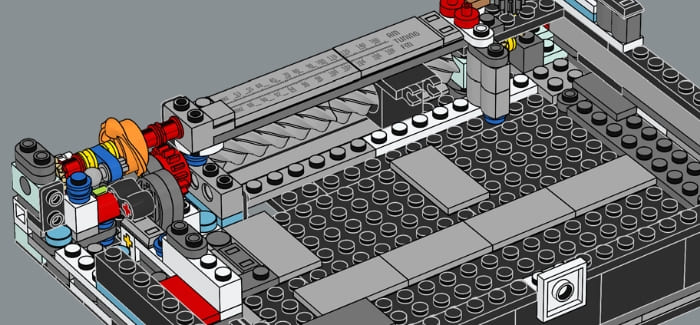
LEGO Technic has several elements that are round with pinholes in the center. That means they can be put on a shaft and rotate, but they don’t really care if the shaft turns or not. Instead, they need to connect on the side with the special ridges. One of these elements is a gear. By connecting the barrel to this gear, they will now both turn when the shaft they are on turns.
In the case of the Retro Radio, the driving action comes when someone is turning the knob that changes the channel. Therefore, when the radio is off, changing the channel only moves the needle left and right. Turning the radio on engages the gear, which then drives the mechanism to press the button on the sound-brick.
Personally, I do like the parts used for building a switch found in this set and the Ducati bike. The designs are much more straightforward and easy to understand. So, if you want to make your own switch that is connected to a rotational machine, check out either of these sets.
LEGO RETRO RADIO – PLAY FEATURES
Adult-oriented LEGO sets aren’t known for their play features. So, it’s rather surprising when a set like this has quite a bit of play involved. First off, there are some fun interactive elements. The AM/FM switch is present and can move, but doesn’t really do anything practical. The antenna can be positioned and moved around, but is also there just for looks. The handle on the other hand, does move and is built to be used as a handle to carry the model around. Then you have the working on and off switch and the working channel dial. Both of these are fun to move and it feels nice to know they are doing something.
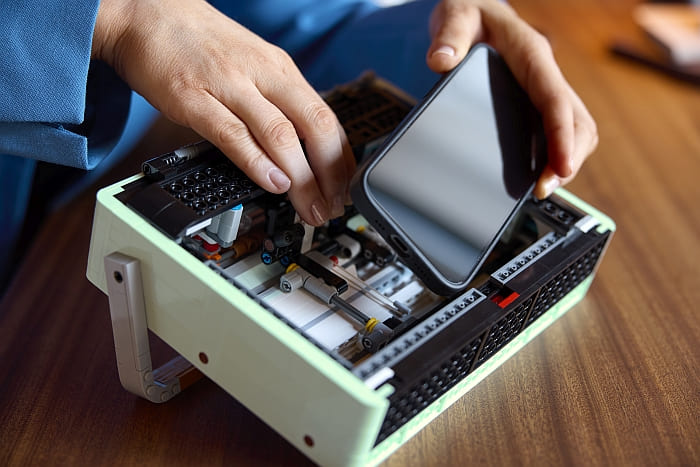
Then, there is the extended play feature you can have by using a smartphone. When you are tired of the few bits of sound the brick provides and actually want to listen to some music, the radio doubles as a carrier for your smartphone. Open up the back and use the cradle system LEGO has designed to keep your phone safe. Turn on your phone’s best playlists, close the model up and now you’re having a true retro radio experience!
LEGO RETRO RADIO – FINAL THOUGHTS
I really wanted to see a sound-brick in action, and I was happy to find it in a non-licensed set. Plus, I have always had a blast with the various retro models LEGO has released in recent years so I gave this one a shot. Even though the cost may be too much for some, I feel this is a fairly priced set.
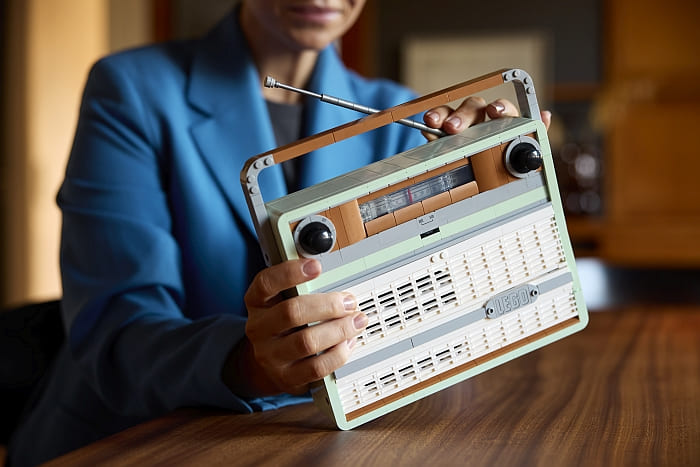
From the outside, the set looks deceptively simple, but it is actually packed with interesting building techniques and provides a wonderful building experience. In the video below, I talk about the set in more detail.
As you can see, a lot is going on here that you won’t notice until you build the set. The set is also a great parts-pack. With that said, it doesn’t give anything to the minifigure lover, nor will it fit with everyone’s style. So, whether or not it belongs in your collection only you can answer. Just take a look at the radio and ask if it fits your style? If not, it’s most likely not for you, and if yes, I highly recommend you give it a try. It’s available at the LEGO Icons section of the Online LEGO Shop.
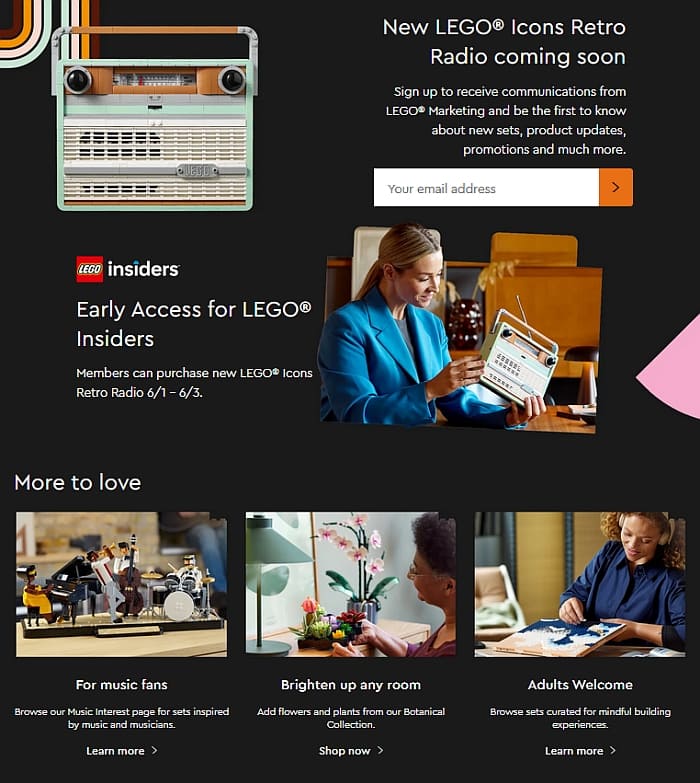
What do you think? How do you like the LEGO Retro Radio? Do you have the set already? Or are you planning to get it? What do you think of the techniques we discussed here? Are there any other interesting features you noticed that we didn’t talk about? Feel free to share your thoughts and own reviews in the comment section below!
And you might also like to check out the following related posts:












I completely missed that this set had a sound brick. Very interesting.
Yeah, I missed that too. I’m also intrigued by the clicking sounds it makes. It’s a more realistic set than I expected.
My grandpa would love this set. He likes tinkering with old radios, and I bet he would have fun building this.
They have done several sets recently in retro colors. I like those a lot. The aqua is especially sweet.